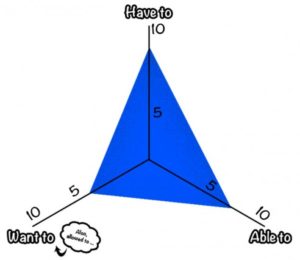by Jennifer Riggins
Lately, I’ve been obsessed with listening to the National Public Radio (NPR), particularly the interviews of authors on topics I would never think of researching myself. A couple weeks ago, scientist Yuval Noah Harari, author of Sapiens: A Brief History of Humankind, was talking about how us homo sapiens have surfaced to the top of the food chain, despite neanderthals having larger brains and chimpanzees simply kicking way more ass with survival skills. So why are we the true kings of the concrete jungle? And how can it make us happier?
“You can never, for example, convince a chimpanzee to do something for you by promising that, ‘Look, after you die, you will go to chimpanzee heaven and there you will receive lots and lots of bananas for your good deeds here on earth, so now do what I tell you to do’.” Basically, our ability to influence and persuade others with intangible beliefs, myths and symbols of value – like religion and money – is what keeps us on top of the world (at least for now.) Individual chimpanzees are much more self-reliant than us homo sapiens, but take a large group of either primate group, and the humans will always win.
While, despite ourselves, we are pretty good at surviving, that doesn’t mean that survival equates to happiness.
“Humans are extremely good in acquiring new power,” Harari said, “but they are not very good in translating this power into greater happiness, which is why we are far more powerful than ever before but we don’t seem to be much happier.”
So, how can we find happiness? Are there myths we can follow so we can fake it until we make it? While the book The Decision Book: Fifty models for strategic thinking presents 50 wonderfully visual and simple models for decision making, it really brings up a lot of quick exercises for deciding specifically what makes you happy. And working for Management 3.0 and constantly in search of ways to make myself and the people I know happier in work and life, I couldn’t help but want to share those ways with you so we can hopefully beat out those hairier primates in the joy department as well.
Happiness Strategy #1: The Personal Performance Model
Or “How to recognize whether you should change your job.” We sadly admit that many if not most people are unhappy in their jobs, but how can you quantify the right time to make a change? Authors Mikael Krogerus and Roman Tschäppeler believe happiness is inherent to your sense of choice and satisfaction. To measure this, every week night for three weeks, draw yourself three lines radiating out from a center zero point. Each line gets marks, counting out to 10 at the end. Label the lines:
1. Have To: How much are my tasks forced upon me?
2. Able To: How much do my tasks match my abilities?
3. Want To: How much do I want to do these tasks? How much do they correspond to my overall goals?
From 1 (not at all) to 10 (all the time,) mark your tasks and then shade in where they connect. After three weeks, do you see the triangular shape changing every day? Or are you stagnant? Is it heading in the direction of Want To or veering away? This will help you decided if you’re ready to make a switch.
Happiness Strategy #2: The John Whitmore Model
Or “Am I pursuing the right goal?” Sir John Whitmore is one of the first modern-day leadership coaches. Big on acronyms, he’s most known for the simpler GROW model but this book decided to cover his method of goal setting. Whitmore argues there are 14 ingredients to a goal’s ultimate success:
SMART: Specific, Measurable, Attainable, Realistic, Time Phased
PURE: Positively stated, Understood, Relevant, Ethical
CLEAR: Challenging, Legal, Environmentally sound, Agreed, Recorded
If a couple of these adjectives don’t describe your current goal, can it be changed to meet them? Or is your goal just really far from reality?
Now, why is this a trick for happiness? Goal setting and working to achieve them are some of the most satisfying things life has to offer. On the other hand, working and working toward ultimate failure can be a real kick in the self esteem.
Happiness Strategy #3: The Role-Playing Model
Or “How to change your own point of view.” Happiness is a self-owned sensation, however we often allow it to be enhanced or depreciated by others, which makes understanding others’ points of view and having them understand ours is an essential factor in happiness. Ever heard “Now, let’s put on our thinking caps, kids” – that probably comes from critical thinking guru Edward de Bono’s 80s classic “The Six Thinking Hats.” When you have a topic to discuss or decision to be made, you can examine it critically from six different perspectives, with each team member wearing a “hat” that guides her perspective:
- White Hat: analytical, objective, focus on facts and feasibility
- Red Hat: emotional, subjective, opinions
- Black Hat: critical thinking, risk assessment, skeptical
- Yellow Hat: optimistic, focused on best-case scenario
- Green Hat: creative, brainstorming
- Blue Hat: structured thinking, looking at the Big Picture
This way your team examines an issue from all sides, and everyone gets to strengthen their critical thinking skills. Plus, if you really get into it, you can wear fun hats and act roles!
In trying to understand our teammates, it helps to know how they think and where they’re coming from. This exercise not only lets us learn a lot about our colleagues, but it allows us to look at topics from different perspectives, giving us a more open – and thus happier – mindset.
Now You Tell Us: What are Your happiness strategies?
What techniques can you offer for personal or professional happiness? For self-happiness or happiness of a group? Please comment below!
Graph from Salem Marafi, Images compliments of Gratisography


